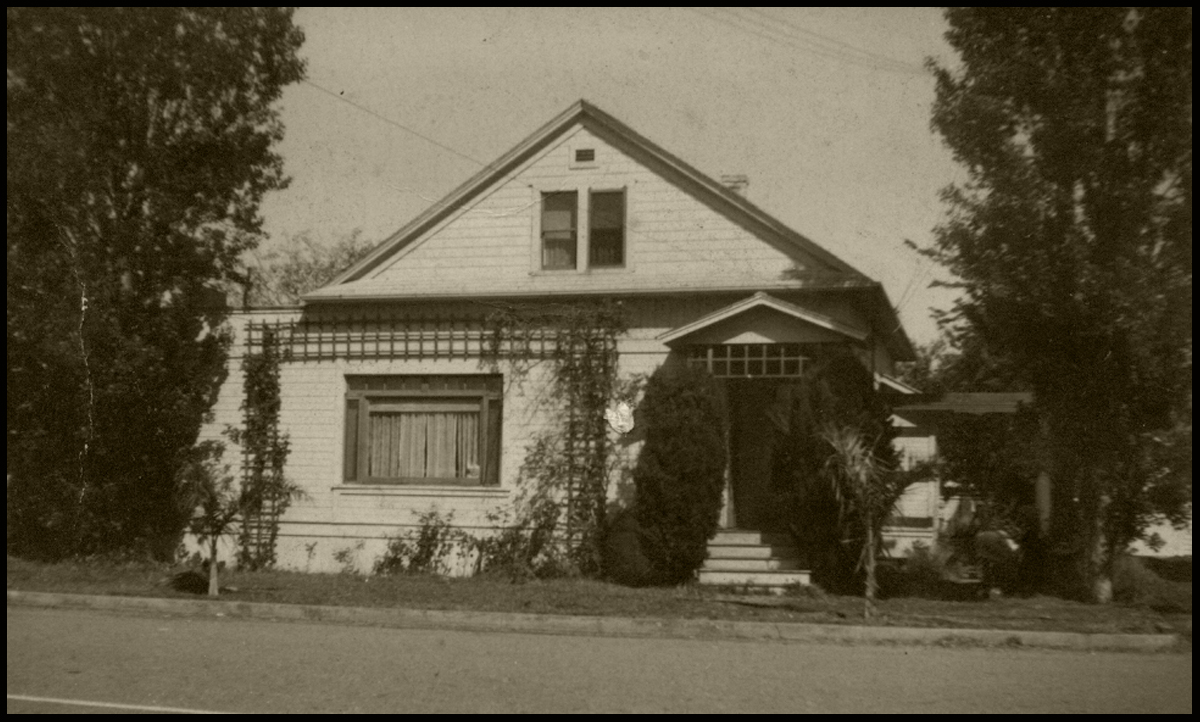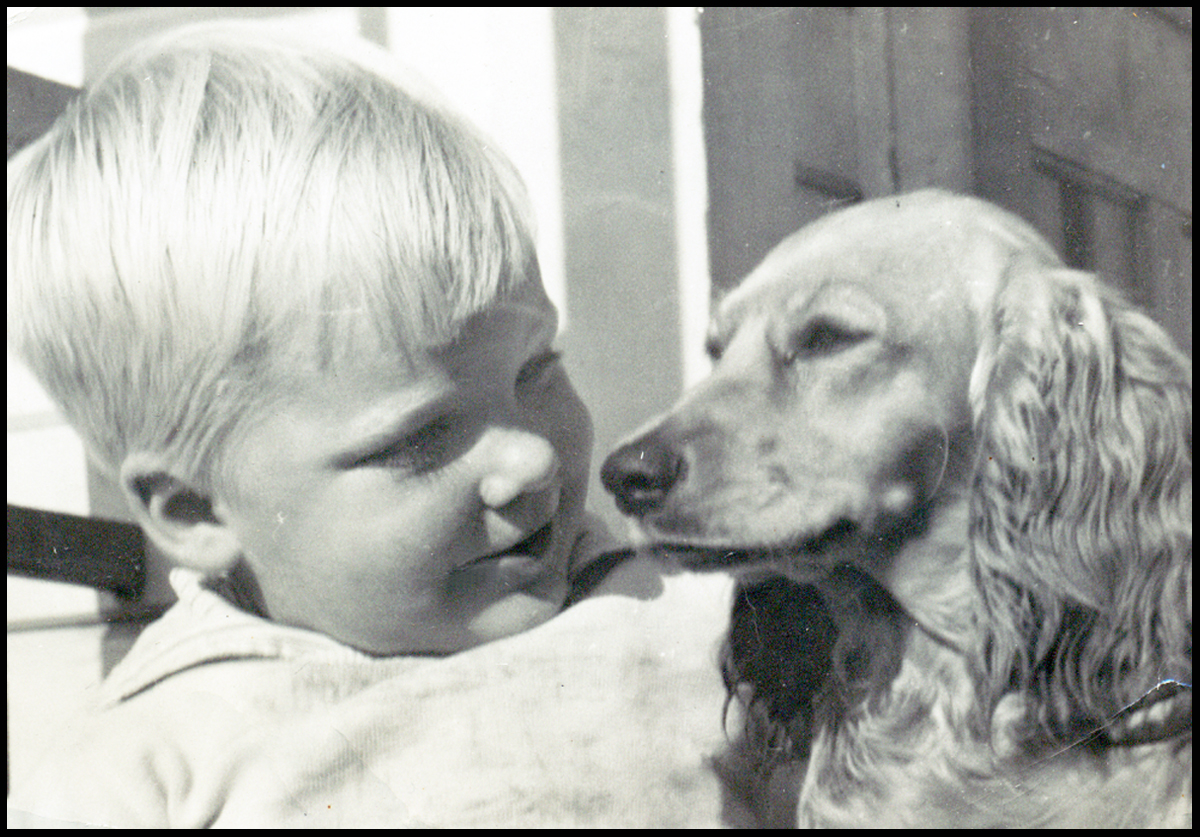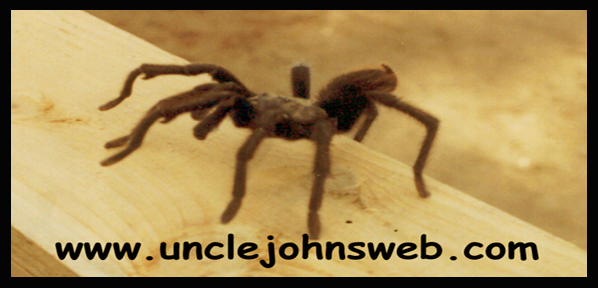
Homemade Ice Cream
On most of my adventures, no cars caught fire on a dark and stormy night.
On an August day in 1947, I was 3 years old, and just starting to take note of events around me that would become my oldest memories. Our grandmother's house in Carpinteria was on Walnut Avenue across from the large playground of Main School.
In that neighborhood, there were always the sounds of kids laughing and playing, the sounds of surf pounding, and trains rumbling by in the night. Huge lemon packinghouses lined the railroad siding and year round there was the smell of lemon and the moldy bits of lemon alongside the streets and loading docks. Beyond the packinghouses a block away and across the tracks, was 100 yards of sprawling beach camp, then some low sand dunes covered with ice plant, then a beautiful sandy oceanfront that ran a half mile to the East and a mile to the West. "World's Safest Beach".
Highway 101, California's main coastal artery, was a two-lane road that came around the hill from the East at Rincon Point. You can follow the original route of 101 by exiting at Bates Road and climbing up from Rincon Creek for a little way then up around to Casitas Pass Road back to what is now Carpinteria Avenue. It ran right through the center of town at Linden Avenue, where it was interrupted by a single red octagonal stop sign, the only stop sign between Ventura and Santa Barbara.
Up on a high bluff at the East end of town, was the "Thunderbowl". It was a simple circular fifth of a mile dirt raceway surrounded by a ten-foot high board fence atop the earthen berm at the edge of the track. On one side was a large viewing stand facing the fence around the rest of the bowl. The fence was painted with advertisements of local businesses. There were midget car races and motorcycle races, but the place was most famous for its "jalopy" races.
Cars in the early 1930's and 1940's had a body in which the passengers rode, with fenders to cover the wheels and running boards bolted on the sides. A jalopy was just a way of stripping a car down into its essential parts in preparation for this rough and tumble low budget form of racing. Taking those fenders off and any other unnecessary sheet metal, taking all the glass out, welding the doors closed, cutting an escape hole in the roof, adding a seat belt, souping up the engine however you could, throwing away the muffler and there you had it: A "thundering" jalopy racer. A jalopy could not have an engine that was newer than 1938, to keep it low budget small town racing fun.
The deal was that there were three ways a driver could cash in. One was to be sponsored by a local merchant. One of course was to win races, and the other was to crash so spectacularly that you careened over the earthen berm and destroyed part of the wood fence. This would result in a bonus for the driver, since that in rebuilding the splintered portion, the Raceway could again sell the ad space to be painted on the new fence.
The lawn in front of Grandma's Walnut Avenue house throughout the 1940's and 1950's was the gathering place for the extended family and the scene of countless group photos; one for siblings, one for cousins, one for each individual family, one with three generations, etc. Easter Sunday would be one such annual occasion to collect a photo album chronicle of how we changed as time went on.

This particular summer day, none of that was happening, just a weekend gathering in which homemade ice cream was going to be churned and that front lawn was the place to do it. A certain recipe of liquid vanilla ice cream had been prepared, chilled overnight, and placed in a metal cylinder with wooden churn called a "dasher". It was spun slowly by hand crank, in a bucket of salted melting ice so as to freeze the creamy mixture in motion and not crystalize.
Well, you needed ice. In my grandmother's house there was a small room she rented out off the front porch. At the time, the occupant was a jalopy race driver named Leroy Carter. The Thunderbowl had just had its Grand Opening a few weeks before. Leroy had joined in the family fun that day and it became his task to handle the ice. In the olden days before there were refrigerators in every household, the icebox was literally that; an insulated box that you put a block of ice in. So every town had an icehouse, even after home refrigeration was widespread. In Carpinteria it was two blocks away. For a few coins, Leroy had come back with a 20-pound block of ice. Standard practice was to use an ice pick to crack it into smaller chunks, put the chunks into a burlap gunny sack and beat the sack with a hard object until the pieces were small enough to slide in between churning metal cylinder and the sides of the bucket. The preferred tool to do this smashing was an axe, using the heavy flat broad side so as not to tear the burlap.
We kids were running around giggling and giddy in anticipation of rich vanilla homemade ice cream. Who was going to get to lick the dasher when it came out? I was three, the very youngest member of the family. I was just beginning to catch on to what any of this was all about, and curious about what Leroy was doing kneeling on the lawn with the gunny sack.
I came around his right elbow from behind, and stepped into the upswing of the very sharp axe. It sliced through the end of my little nose. My sisters watched it happen. Suddenly there were screams instead of giggles and bright red blood splattering on everything that been had white and rosy. Blood, blood, blood.
I don't have an actual memory of that day up to this point in the story. I've reconstructed it from what I've been told. The next hour, however, I remember vividly.
We were in my Aunt Virginia's car on our way to Santa Barbara. I was lying on my mother's lap in the passenger seat. She was holding a white cloth on my face. I could see my blood on it, and on her dress and the seat. We got to a clinic or hospital and went inside. I was put on a gurney and taken down a hall and into a room where they were going to stitch up my nose. I knew what was going to happen. I remember them putting a gauze pad with ether on my face.
What happened next is that I had the feeling of floating out of my body, and once free, flying out of the room through the venetian blinds and out into the parking lot and into the back seat of Aunt Virginia's car. I hid there while the doctor sewed up that poor kid (that was me) on that operating table. Then I went to sleep.
I had had an out-of-body experience at age three. I didn't tell anybody about it. I was over 20 when I learned what it was and that other people had experienced similar things on ether. Until then it was my personal secret that I had escaped my body when I needed to. This was one of the cornerstones of my feeling of mystic immortality; and probably my risk taking and recklessness. It wasn't a superpower, it was a common illusion under anesthesia.
In a related memory, about 18 months later, we were living in an apartment complex in San Pedro. We were taught our address and phone number in case we ever got lost. We were drilled to NEVER forget them. And I haven't: 1617 A Weymouth, our phone, TErminal 21657
.
In the basement below our apartment was a laundry room. On one wall there were big sinks, and over the sinks, windows that opened into a light well outside. One window was broken with small triangular pieces of glass still imbedded in the putty. I didn't like the looks of that, I recall, and I climbed up began to pull the pieces out. Next thing I know, I've sliced the back of my little finger to the bone. Blood, blood, blood. Once again, I've traumatized my sisters, who are in charge of the screaming.
It wasn't that big a deal to my mom, though. She had had some nurse's training, and would patch up small injuries when she was a lifeguard at Carpinteria Beach. She asked me whether I wanted it stitched up, or let her put a splint and bandages on it at home. I remembered the spooky thing that happened to me the last time I was stitched up. I didn't want that again, so she strapped it to an ice cream stick with adhesive tape and gauze. It left a neat scar across the base of my right pinky. It would come in handy when I was learning left from right. It's still there.
There must be a great mystery to life; some secret connections obscured behind the visible surface of everything, a hidden lattice supporting all. Flying out of my body? What does that mean? Was I rescued? Or maybe it was possible to leave my body. And if I did separate, would I be able to find my way back? I remember when that had happened. It was scary and I didn't want it to happen again, so I took the splint. I like being in my body.





Copyright © 2022 John Oliver
All Rights Reserved
mail@unclejohnsweb.com

On an August day in 1947, I was 3 years old, and just starting to take note of events around me that would become my oldest memories. Our grandmother's house in Carpinteria was on Walnut Avenue across from the large playground of Main School.
In that neighborhood, there were always the sounds of kids laughing and playing, the sounds of surf pounding, and trains rumbling by in the night. Huge lemon packinghouses lined the railroad siding and year round there was the smell of lemon and the moldy bits of lemon alongside the streets and loading docks. Beyond the packinghouses a block away and across the tracks, was 100 yards of sprawling beach camp, then some low sand dunes covered with ice plant, then a beautiful sandy oceanfront that ran a half mile to the East and a mile to the West. "World's Safest Beach".
Highway 101, California's main coastal artery, was a two-lane road that came around the hill from the East at Rincon Point. You can follow the original route of 101 by exiting at Bates Road and climbing up from Rincon Creek for a little way then up around to Casitas Pass Road back to what is now Carpinteria Avenue. It ran right through the center of town at Linden Avenue, where it was interrupted by a single red octagonal stop sign, the only stop sign between Ventura and Santa Barbara.
Up on a high bluff at the East end of town, was the "Thunderbowl". It was a simple circular fifth of a mile dirt raceway surrounded by a ten-foot high board fence atop the earthen berm at the edge of the track. On one side was a large viewing stand facing the fence around the rest of the bowl. The fence was painted with advertisements of local businesses. There were midget car races and motorcycle races, but the place was most famous for its "jalopy" races.
Cars in the early 1930's and 1940's had a body in which the passengers rode, with fenders to cover the wheels and running boards bolted on the sides. A jalopy was just a way of stripping a car down into its essential parts in preparation for this rough and tumble low budget form of racing. Taking those fenders off and any other unnecessary sheet metal, taking all the glass out, welding the doors closed, cutting an escape hole in the roof, adding a seat belt, souping up the engine however you could, throwing away the muffler and there you had it: A "thundering" jalopy racer. A jalopy could not have an engine that was newer than 1938, to keep it low budget small town racing fun.
The deal was that there were three ways a driver could cash in. One was to be sponsored by a local merchant. One of course was to win races, and the other was to crash so spectacularly that you careened over the earthen berm and destroyed part of the wood fence. This would result in a bonus for the driver, since that in rebuilding the splintered portion, the Raceway could again sell the ad space to be painted on the new fence.
The lawn in front of Grandma's Walnut Avenue house throughout the 1940's and 1950's was the gathering place for the extended family and the scene of countless group photos; one for siblings, one for cousins, one for each individual family, one with three generations, etc. Easter Sunday would be one such annual occasion to collect a photo album chronicle of how we changed as time went on.

Well, you needed ice. In my grandmother's house there was a small room she rented out off the front porch. At the time, the occupant was a jalopy race driver named Leroy Carter. The Thunderbowl had just had its Grand Opening a few weeks before. Leroy had joined in the family fun that day and it became his task to handle the ice. In the olden days before there were refrigerators in every household, the icebox was literally that; an insulated box that you put a block of ice in. So every town had an icehouse, even after home refrigeration was widespread. In Carpinteria it was two blocks away. For a few coins, Leroy had come back with a 20-pound block of ice. Standard practice was to use an ice pick to crack it into smaller chunks, put the chunks into a burlap gunny sack and beat the sack with a hard object until the pieces were small enough to slide in between churning metal cylinder and the sides of the bucket. The preferred tool to do this smashing was an axe, using the heavy flat broad side so as not to tear the burlap.
We kids were running around giggling and giddy in anticipation of rich vanilla homemade ice cream. Who was going to get to lick the dasher when it came out? I was three, the very youngest member of the family. I was just beginning to catch on to what any of this was all about, and curious about what Leroy was doing kneeling on the lawn with the gunny sack.
I came around his right elbow from behind, and stepped into the upswing of the very sharp axe. It sliced through the end of my little nose. My sisters watched it happen. Suddenly there were screams instead of giggles and bright red blood splattering on everything that been had white and rosy. Blood, blood, blood.
I don't have an actual memory of that day up to this point in the story. I've reconstructed it from what I've been told. The next hour, however, I remember vividly.
We were in my Aunt Virginia's car on our way to Santa Barbara. I was lying on my mother's lap in the passenger seat. She was holding a white cloth on my face. I could see my blood on it, and on her dress and the seat. We got to a clinic or hospital and went inside. I was put on a gurney and taken down a hall and into a room where they were going to stitch up my nose. I knew what was going to happen. I remember them putting a gauze pad with ether on my face. What happened next is that I had the feeling of floating out of my body, and once free, flying out of the room through the venetian blinds and out into the parking lot and into the back seat of Aunt Virginia's car. I hid there while the doctor sewed up that poor kid (that was me) on that operating table. Then I went to sleep.
I had had an out-of-body experience at age three. I didn't tell anybody about it. I was over 20 when I learned what it was and that other people had experienced similar things on ether. Until then it was my personal secret that I had escaped my body when I needed to. This was one of the cornerstones of my feeling of mystic immortality; and probably my risk taking and recklessness. It wasn't a superpower, it was a common illusion under anesthesia.
In a related memory, about 18 months later, we were living in an apartment complex in San Pedro. We were taught our address and phone number in case we ever got lost. We were drilled to NEVER forget them. And I haven't: 1617 A Weymouth, our phone, TErminal 21657
. In the basement below our apartment was a laundry room. On one wall there were big sinks, and over the sinks, windows that opened into a light well outside. One window was broken with small triangular pieces of glass still imbedded in the putty. I didn't like the looks of that, I recall, and I climbed up began to pull the pieces out. Next thing I know, I've sliced the back of my little finger to the bone. Blood, blood, blood. Once again, I've traumatized my sisters, who are in charge of the screaming.
It wasn't that big a deal to my mom, though. She had had some nurse's training, and would patch up small injuries when she was a lifeguard at Carpinteria Beach. She asked me whether I wanted it stitched up, or let her put a splint and bandages on it at home. I remembered the spooky thing that happened to me the last time I was stitched up. I didn't want that again, so she strapped it to an ice cream stick with adhesive tape and gauze. It left a neat scar across the base of my right pinky. It would come in handy when I was learning left from right. It's still there.
There must be a great mystery to life; some secret connections obscured behind the visible surface of everything, a hidden lattice supporting all. Flying out of my body? What does that mean? Was I rescued? Or maybe it was possible to leave my body. And if I did separate, would I be able to find my way back? I remember when that had happened. It was scary and I didn't want it to happen again, so I took the splint. I like being in my body.





Copyright © 2022 John Oliver
All Rights Reserved
mail@unclejohnsweb.com

All Rights Reserved
mail@unclejohnsweb.com
